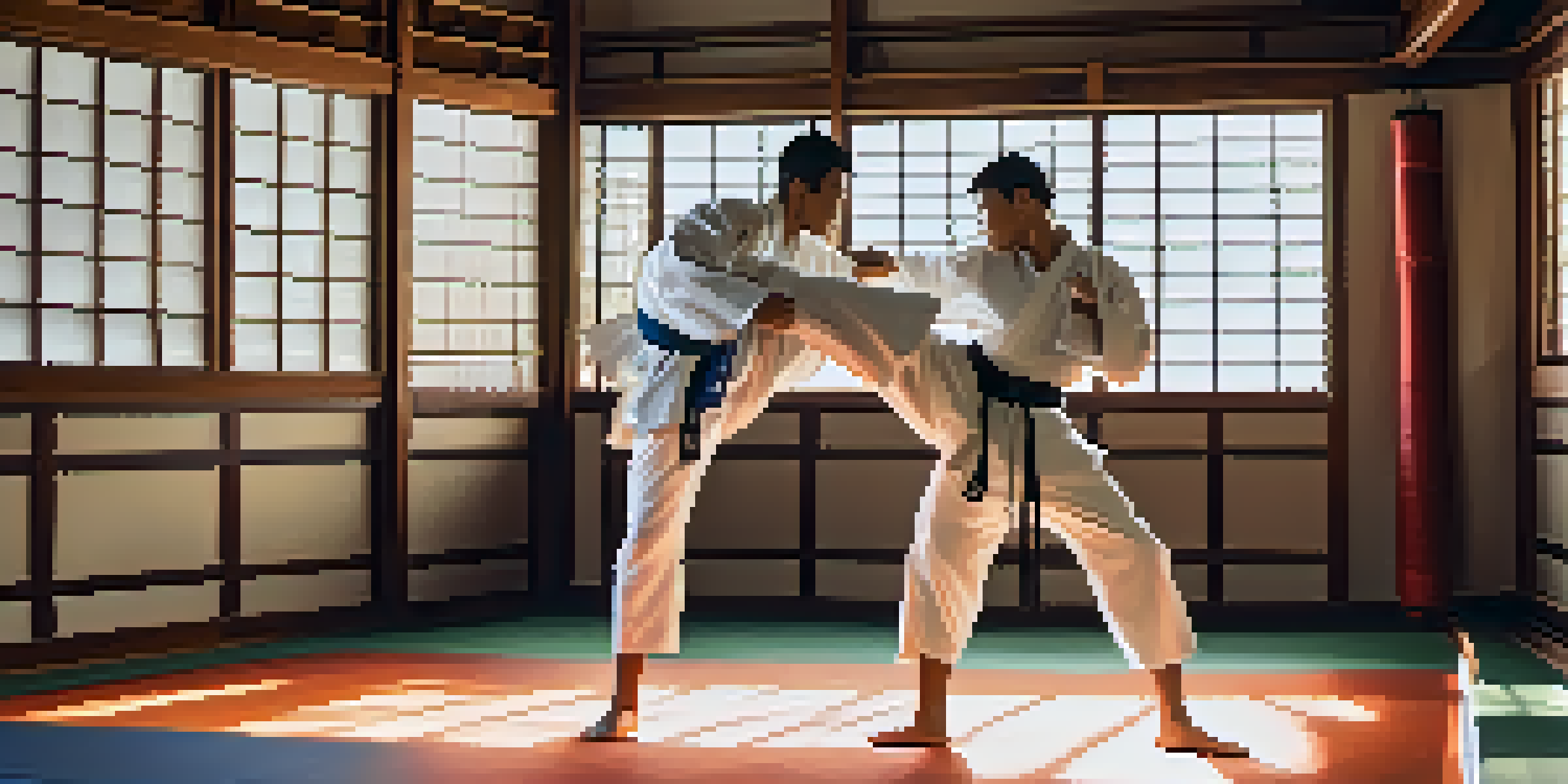The Science of Sparring: Techniques for Effective Training

Understanding the Purpose of Sparring in Training
Sparring serves as a practical application of techniques learned during training. It allows practitioners to test their skills in a controlled environment, enhancing their understanding of timing, distance, and strategy. Think of it as a rehearsal for the main event—where you can experiment and refine your approach without the stakes being too high.
In the middle of difficulty lies opportunity.
Additionally, sparring fosters a deeper connection with your training partners, promoting teamwork and camaraderie. It's not just about individual prowess; it's about learning from each other and growing together. This collaborative aspect can make your training sessions more enjoyable and effective.
Moreover, sparring helps in identifying weaknesses and areas for improvement. By facing different opponents with varying styles, you can pinpoint specific techniques that need work, ultimately leading to a more well-rounded skill set.
Key Techniques to Enhance Sparring Effectiveness
One essential technique is the ability to maintain proper stance and footwork. A solid stance provides balance and facilitates quick movement, allowing you to evade attacks and launch counters effectively. Think of your stance as the foundation of a house; without a strong base, everything else can crumble.

Another important technique is developing effective breathing patterns. Staying relaxed and focused helps you manage stress during sparring sessions, enhancing your performance. Just as a musician must learn to control their breath to hit the right notes, you too must master your breath to maintain clarity and precision.
Sparring Enhances Skill Application
Sparring allows practitioners to apply techniques in a controlled environment, improving their timing, distance, and strategy.
Lastly, consider incorporating feints and deception into your sparring techniques. By tricking your opponent into reacting to a false move, you can create openings for your real attacks. It’s akin to a magician performing a sleight of hand—keeping your opponent guessing can give you the upper hand.
The Importance of Mental Preparation in Sparring
Mental preparation is just as crucial as physical training when it comes to sparring. Visualizing your techniques and anticipating possible opponent moves can significantly enhance your performance. Imagine a chess player thinking several moves ahead; this strategy applies perfectly in sparring as well.
The more you sweat in training, the less you bleed in battle.
Additionally, cultivating a positive mindset can help you stay calm and focused during sparring sessions. Approach each sparring match as a learning opportunity rather than a competition. This shift in perspective can alleviate pressure and allow you to perform at your best.
Practice mindfulness techniques, such as meditation or deep breathing, to improve your mental resilience. By training your mind, you’ll be better equipped to handle the unpredictability and challenges of sparring, just like an athlete prepares for the pressure of a big game.
Safety Measures to Implement During Sparring
Safety should always be a top priority during sparring sessions. Wearing appropriate protective gear, such as headgear, gloves, and shin guards, helps minimize the risk of injury. Think of this gear as your safety net—protecting you while you push your limits.
Establish clear rules and communication with your sparring partners before starting. Agree on the intensity level and any specific techniques to avoid. This mutual understanding creates a safer environment where everyone can focus on improving rather than worrying about getting hurt.
Mental Prep Boosts Sparring Success
Effective mental preparation, including visualization and mindfulness, enhances performance during sparring sessions.
Finally, always listen to your body. If you feel fatigued or notice any pain, it’s essential to take a break. Just like a car needs regular maintenance to run smoothly, your body requires attention and care to perform at its best during sparring.
Analyzing Performance Post-Sparring for Improvement
After each sparring session, take time to analyze your performance critically. Reflect on what worked well and what didn’t, noting specific techniques or strategies that need adjustment. This reflective practice acts like a mirror, helping you see your strengths and areas for development more clearly.
Consider recording your sparring sessions if possible. Watching the footage allows you to observe your movements and decision-making in real-time. Just as athletes study game tape to improve their performance, you can gain valuable insights from your sparring videos.
Lastly, seek feedback from your training partners and coaches. They can offer fresh perspectives and constructive criticism that you might not have considered. Collaboration in your learning journey can propel your skills to new heights.
Integrating Sparring into Your Overall Training Regimen
To maximize the benefits of sparring, it’s essential to integrate it into your overall training regimen. Balance sparring sessions with skill drills, conditioning, and technique refinement to ensure a comprehensive approach. Think of it as a well-rounded diet—variety is key to maintaining optimal performance.
Set specific goals for each sparring session. Whether focusing on a particular technique or improving your defensive skills, having a clear objective can enhance your training effectiveness. Like a roadmap guides a traveler, your goals will steer your sparring efforts in the right direction.
Safety is Crucial in Sparring
Wearing protective gear and establishing clear rules ensures a safe sparring environment, allowing for focused training.
Lastly, adapt your sparring frequency based on your current level and training phase. Beginners may need more frequent sparring to build confidence, while advanced practitioners might focus on selective sparring to refine specific techniques. Tailoring your approach ensures that you get the most out of each session.
The Role of Sparring in Building Confidence and Skill
Sparring plays a significant role in building both confidence and skill in martial arts. Each successful session reinforces your abilities and helps you become more comfortable in challenging situations. It’s similar to riding a bike; the more you practice, the more confident you become in your abilities.
Moreover, sparring exposes you to various styles and strategies, allowing you to adapt and evolve as a martial artist. Encountering different opponents helps you develop a versatile skill set, preparing you for any situation that may arise in competition. This adaptability is a crucial asset in your training journey.

Finally, the camaraderie developed through sparring can boost your motivation and enjoyment. Training with others fosters a sense of community, making the journey more rewarding. Together, you can celebrate each other’s progress, making every sparring session an opportunity for growth.